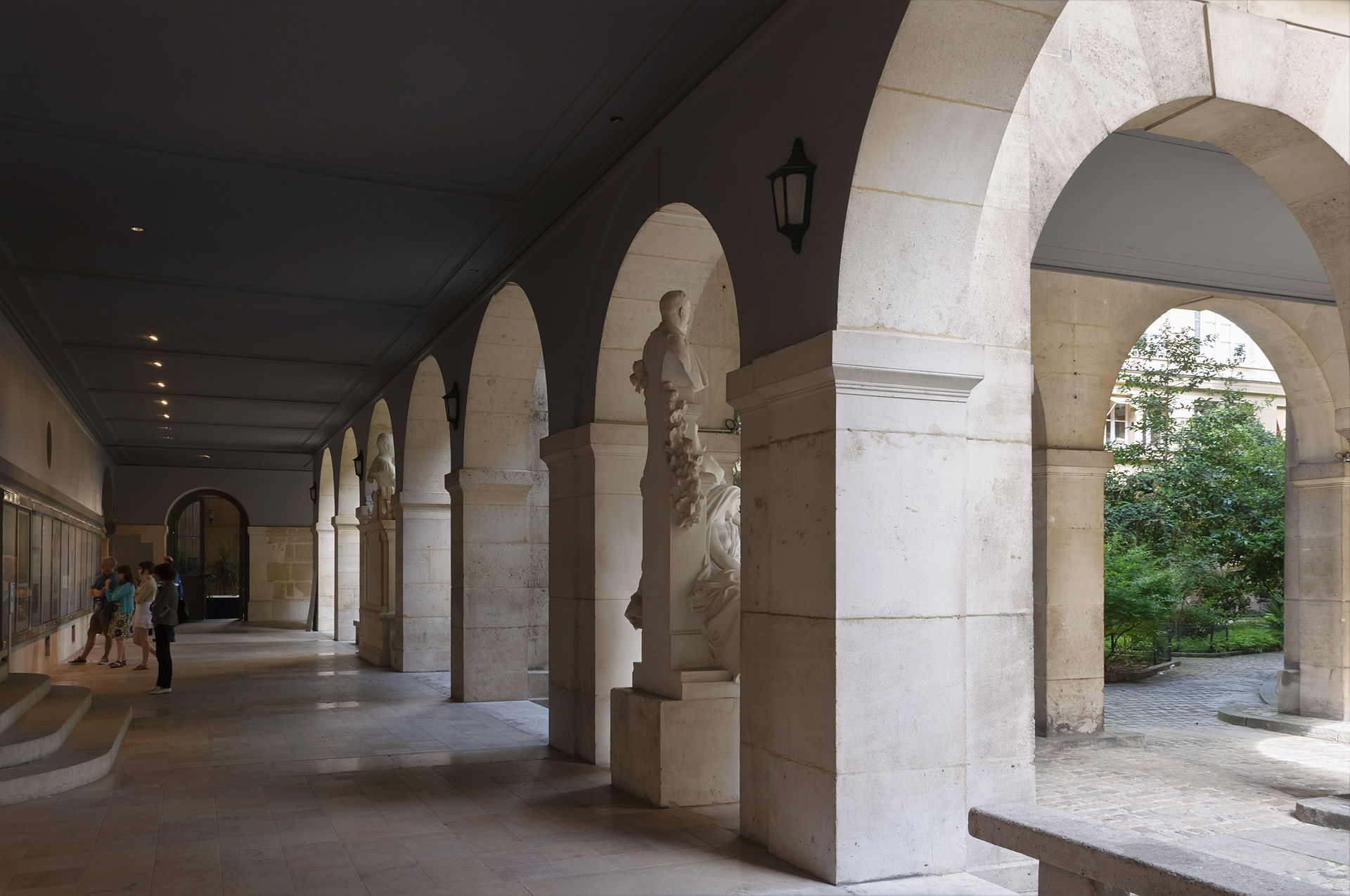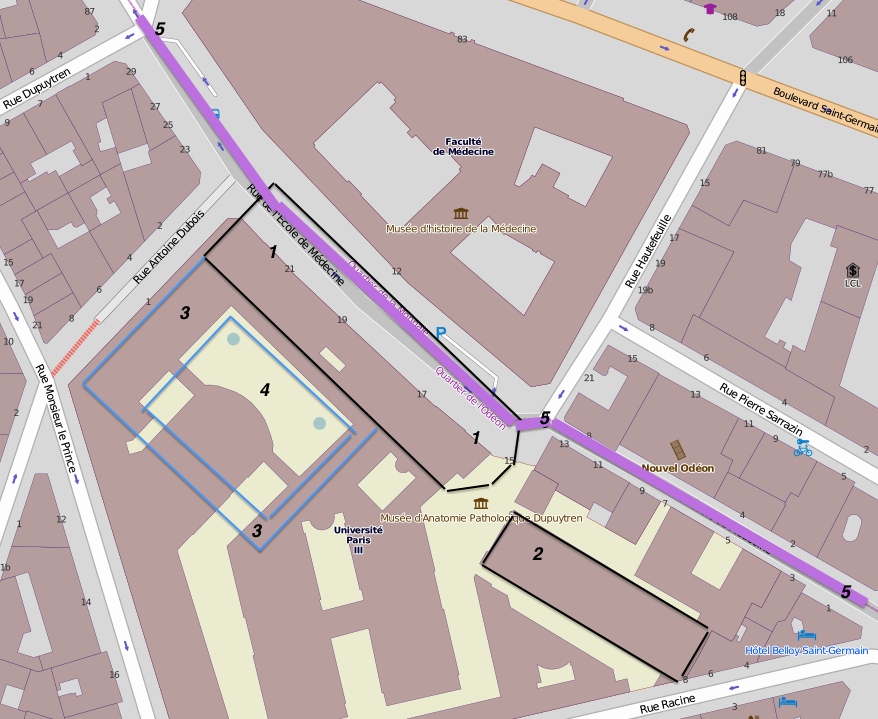XIIIth - XVIIIth cent. The Cordeliers Convent
Cordeliers is the French familiar denomination for the Ordo fratrum minorum, the Franciscan Friars.It is derived from the rope (= corde in French) that these poverty-oriented monks wore instead of a belt.
The phrase Campus des Cordeliers means Campus located where the Convent of the Franciscan Friars once stood.
-
Creation
Remember that the XIIIth century saw a vast expansion all over Europe of the newly-created Mendicant Orders, i.e. Franciscans and Dominicans (Ordo Praedicatorum). The Dominicans had their main house in Paris as early as 1218, rue Saint Jacques (hence their familiar denomination of Jacobins).
The Franciscans took advantage of the benevolence of King Louis IX (later Saint Louis), who according to tradition belonged to the Third Order of St Francis.
The abbot of Saint-Germain des Prés had alloted them the ground, the king paid for the building, from 1230 to 1270.
- The church, dedicated to St. Magdalen, was one ot the largest in Paris (95 metres long)
- There was of course a cloister, as well as conventual
buildings such as the refectory or dining hall (1360 - the only
part that stands today)
- A College that was part of the University of Paris.
-
XVIth cent. (Renaissance)
- The College opens an anatomy lab for surgeons.
The medical tradition of the place is born - it is alive up to now (rue de l'École de Médecine translates as Medical School Street)
It becomes the seat of the Académie royale de chirurgie ( = Royal College of Surgeons) which is later (1769) transferred across the street to the former Collège de Bourgogne.
- Nov.1580 : A fire destroys church and cloister.
They are rebuilt one century later, with gardens designed by Le Nôtre (the creator of the park at Versailles) .
- The College opens an anatomy lab for surgeons.
-
Detailed location
The place where the Welcome Reception is held is partly within the space once occupied by the church (destroyed in 1795).

Today (Wikipédia)

1793 (Wikipédia)
1. The church. 2. The refectory 3. Later conventual buildings (XVIIth cent.) 4. Courtyard (former cloister) 5. rue de l'École de Médecine

OpenStreetMap. Convent location : p. 26 of Les Cordeliers dans la Révolution française, vol.1, by Jacques De Cock
French Revolution (1789 - 1799)
- Like all monasteries, the Cordeliers convent is closed. The
60 monks that remained at the time are transferred to other places.
The buildings and their contents are nationalized (they become "bien national").
-
The Club des Cordeliers, 1790 - 1795
In the turmoil of revolutionary Paris, several groups of citizens (a.k.a. think tanks) exerted a major influence.
The two main ones were the club des Jacobins and the club des Cordeliers, so called because they first met in convents that had been nationalized :
one in a Dominican convent (rue Saint-Honoré, not the main one in the rue Saint-Jacques), the other at the Cordeliers'.
The Jacobins had the major impact (hence the popular concept of Jacobin politics), but the Cordeliers was also a very influential group,
with famous figures like Danton, Marat, Camille Desmoulins.
One episode about Danton will be enough to illustrate the violence of the period:
La Patrie en danger
During the summer of 1792, France is at war with Austria. The Duke of Brunswick and the émigrés cross the border, besiege Verdun and march toward Paris.
- On Sept. 2nd, Danton as a Cabinet minister
impulses national
defense. His talk at the Assemblée législative is famous :
Le tocsin qu’on va sonner n’est point un signal d’alarme, c’est la charge sur les ennemis de la patrie. Pour les vaincre, il nous faut de l’audace, encore de l’audace, toujours de l’audace, et la France est sauvée.
[ Very approximate translation : The bell that will ring is not for danger, it heralds charge on the enemies of our country. To overcome we need boldness, more boldness, boldness again, and France will be saved.]
As a consequence of his action, on Sept. 20th the victory of Valmy stops the invasion. On Sept. 21st the Republic is proclaimed.
- On the evening of the same day, Sept. 2nd,
start the September Massacres
(about
1500 persons killed in various prisons, suspected of connections with
the Austrian army).
Minister Danton does not move to stop them.
- On Sept. 2nd, Danton as a Cabinet minister
impulses national
defense. His talk at the Assemblée législative is famous :
- December 1794 : an "École de santé" (Medical School)
is installed in the former convent.
This is a consequence of the suppression in 1793 of the old Université de Paris (from 1150...), replaced by a system of specialized schools.
- Autumn 1795 : The church is destroyed. Only the réfectoire
remains today.
- 1796 The former rue des Cordeliers becomes rue
de l'École de Médecine
XIXth cent. : Medical
School
- The former Université de Paris, of medieval fame,
deteriorated in the modern age.
It was suppressed in 1793.
The former Faculté de Médecine was also suppressed.
- 1806 - 1808 Emperor Napoléon creates a new educational system
in France, called Imperial University.
1808 a new Faculté de Médecine is created in the new system, with its seat at the former Royal College of Surgeons, on Medical School Street.
- 1896 Together with the Faculties of Law, Letters and
Sciences, it is incorporated in the new Université de Paris.
Note that the famous name la Sorbonne traditionally designated the Faculties of Letters and Sciences.
The Faculté de Médecine was not part of la Sorbonne. It was colloquially referred to as la Faculté.
XXth cent.
-
Edgar Faure Law
As a direct consequence of the May 1968 events, a law is passed (Nov. 12th, 1968) under the leadership of Edgar Faure, then Minister of Education,
to completely restructure the French University system.
The Université de Paris is split up in 13 new Universities, each of which in due time adopted a proper name, e.g.:
- Paris 3 = Université Sorbonne Nouvelle
- Paris 5 = Université René Descartes, which has its seat across the rue de l'École de Médecine
- Paris 6 = Université Pierre et Marie Curie, with
a main campus Place Jussieu
- Paris 3 = Université Sorbonne Nouvelle
-
Multi-disciplinary universities
Each of the new universities created by the law was supposed to cover a broad spectrum of disciplines, without well-defined borders.
All the former Facultés were distributed among several new universities.
Medical studies in particular are now to be found in (at least)
- Université René Descartes (Paris 5)
- Université Pierre et Marie Curie (Paris 6)
- Université Denis Diderot (Paris 7)
- Université Paris-Sud (Paris 11)
It is to be noted that virtually each of the universities reinstated the name of Faculté: on the Internet you will find
- Faculté de Médecine Paris Descartes
- Faculté de médecine Pierre et Marie Curie
- etc.
- Université René Descartes (Paris 5)
-
The Cordeliers area
- The greater part of the buildings on the former
Cordeliers convent was alloted to the Faculté de Médecine Paris
Descartes
- As regards Université Pierre et Marie, its main
medical centers are three big hospitals (Saint-Antoine, Pitié-Salpêtrière
and a part of Broussais Hôtel Dieu).
The Campus des Cordeliers is a smaller part of Faculté de médecine Pierre et Marie Curie.
It is used by a research lab, the Centre de recherche des Cordeliers - UMR_S 872,
as well as by some administrative offices (graduate studies and lifelong learning).
And also to host receptions on festive occasions such as AAMAS-2014...
- The greater part of the buildings on the former
Cordeliers convent was alloted to the Faculté de Médecine Paris
Descartes